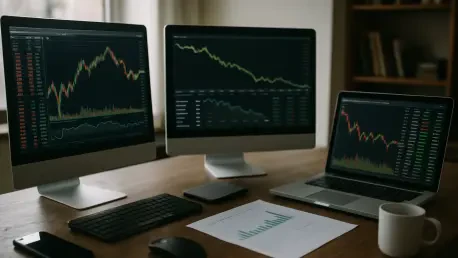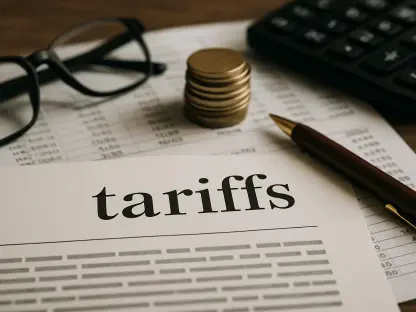In a notable shift in strategy, the Philippine government is actively encouraging retail investors to participate in Treasury bond (T-bond) auctions. This change is not merely a local fiscal tactic but a significant development in the nation’s broader market landscape, impacting both domestic and international financial arenas. By engaging retail investors, the government aims to achieve a ₱2.55 trillion borrowing target for 2025, reflecting 5.3% of the country’s GDP. This move is strategically aligned with deepening the domestic capital market and reducing reliance on institutional buyers, thus reshaping the country’s fiscal strategy.
Expanding Retail Participation
Impact on Yield Dynamics and Investor Appeal
Retail involvement in T-bond auctions is considerably affecting yield dynamics, offering diversification opportunities in emerging market debt. A vivid instance of this is reflected in the June 2025 auction, wherein the government aimed to raise ₱30 billion through reissued nine-year T-bonds. Despite the auction concluding with ₱27.6 billion raised, it attracted overwhelmingly high total bids, amassing ₱55.4 billion and achieving 1.8 times oversubscription. This strong demand, even with a notable 6.428% yield, underscores the allure of Philippine bonds amidst global financial uncertainty driven by factors like geopolitical tensions and fluctuating oil prices.
The retail push is further facilitated through initiatives like the 30th Tranche of Retail Treasury Bonds (RTB30), which have a minimum investment threshold of ₱5,000 and offer a 6.250% coupon with quarterly interest returns. Moreover, the innovative introduction of tokenized Treasury bonds (TTBs) in 2023 has considerably enhanced retail access to sovereign debt markets using digital advancements. Such steps have brought about a revolution in retail participation by lowering entry barriers and broadening the investor pool. This approach has also led to reduced dependency on traditional institutional investors, marking a transformative phase in the Philippine financial landscape.
Strategic Implications of Retail Involvement
The strategic implications of increased retail participation in Treasury bond auctions are manifold, significantly influencing investment portfolios. T-bonds in the Philippines present a diverging strategy for fixed-income portfolios, largely due to their low correlation with U.S. Treasuries and exposure to distinct growth trajectories linked to Asian economies. During April 2025, for instance, the yield on the 2030 T-bond was pegged at 5.896%, charting a sizable 344 basis point spread over German Bunds, enhancing its appeal among investors keen on yield-seeking avenues.
For retail investors, direct holdings or participation through mutual funds offer significant diversification perks. Considering the Philippines’ fiscal prudence, as depicted by a budget deficit of ₱1.54 trillion in 2025 and a robust inflation rate of 0.3% as of April 2025, retail investors stand to gain a hedge against potential currency volatility and interest rate hikes prevalent in mature markets. This prudent fiscal approach enhances the attractiveness of Philippine T-bonds as a safe and rewarding investment opportunity within emerging markets.
Technological Innovation and Market Accessibility
Digital Tools and Their Role
The Philippine Bureau of the Treasury’s implementation of digital tools like tokenized Treasury bonds has played a crucial role in expanding market accessibility. By adopting digital finance trends, the bureau has successfully reduced barriers for retail investors to engage with sovereign debt, integrating technology into traditional investment frameworks. Tokenization has simplified the process of investing in Treasury bonds, providing small-scale investors the opportunity to partake in what was once predominantly an institutional play. This initiative has not only fostered greater engagement from local investors but also aligned with global movements towards a more inclusive and democratized financial system.
The use of such technological advancements has also been instrumental in diversifying the domestic investor base. By enabling broader participation, the Philippine government has ensured healthier competition in primary markets and facilitated deeper liquidity in secondary markets. Consequently, this has led to a more balanced yield curve and has strengthened overall investor confidence. Embracing technology in this manner has proven pivotal in transitioning the bond market into a more dynamic and resilient sector, with retail investors firmly at its core.
Long-term Benefits and Financial Stability
Looking at the long-term advantages, the strategic embrace of retail investment not only supports government borrowing needs but also enhances financial stability. With the Bangko Sentral ng Pilipinas implementing a dovish monetary policy, including a 25-basis-point rate cut, investor confidence remains bolstered. The attractive yields matched with investment-grade security positions Philippine T-bonds as a very appealing investment vehicle in comparison to international alternatives. This strategic expansion reinforces fiscal sustainability by diversifying funding sources and insulating the economy against external shocks.
Furthermore, the Bureau of the Treasury’s preference for long-term debt, comprising 75% of 2025’s borrowing agenda, equips investors with opportunities to exploit extended maturity profiles. This strategy not only benefits investors by offering high yields but also ensures the state’s capacity to manage debt in a controlled manner. Thus, the concerted efforts to involve retail investors and utilize digital innovations have positioned the Philippines as a growth-centric hub in the global financial ecosystem, optimizing both domestic financial health and international investment appeal.
Future Outlook on the Philippine Bond Market
Navigating Geopolitical Challenges
As the Philippine bond market evolves, its resilience in the face of geopolitical challenges plays a pivotal role in maintaining investor enthusiasm. Global uncertainties, from conflicts to economic shifts, typically exert upward pressure on bond yields. However, the Philippines’ stable macroeconomic climate offers a layer of protection against these global instabilities. This stability, characterized by disciplined fiscal policies and effective monetary regulation, shields the market from exacerbated volatility that might otherwise deter investment.
Investors and analysts alike must stay vigilant regarding any monetary policy shifts by the Bangko Sentral ng Pilipinas and government fiscal directives. These factors are crucial in determining optimal entry points and timing within the bond market. The Philippines’ capacity to navigate these geopolitical tensions while sustaining an inviting investment climate underscores its growing stature as a reliable emerging market player, with tangible potential for further integration into the global financial network.
Strategic Gains for Investors
In a strategic shift, the Philippine government is now actively urging retail investors to partake in Treasury bond (T-bond) auctions. This isn’t just a local financial maneuver but a major evolution in the nation’s market dynamics, affecting both domestic and international financial sectors. This approach aims to help the government meet a ₱2.55 trillion borrowing target for 2025, which represents 5.3% of the country’s GDP. By tapping into the retail market, the government intends to deepen the domestic capital market while reducing dependency on institutional buyers. This initiative not only broadens investment opportunities for individual investors but also promotes a more diversified investor base. As a result, the nation’s fiscal strategy is undergoing transformation, reflecting a commitment to enhancing market depth and stability. By integrating retail investors into the bond market, the Philippines is looking to secure a more balanced and resilient financial ecosystem, fostering long-term economic growth and sustainability.









